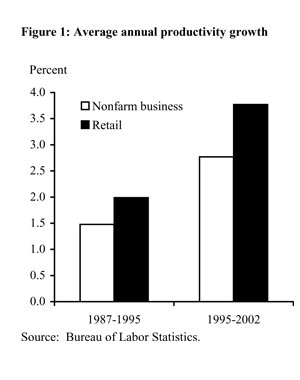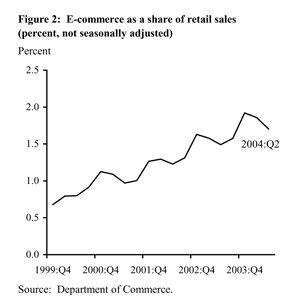The phenomenal performance of labor productivity that has marked the U.S. since the mid-1990s has not only fostered economic growth and real gains in wages, but it also has kept economists busy trying to understand its underlying causes. Many studies focus on the broad economy and find that information technology (IT) has played a major role.
- An overview of the retail sector
- Why did productivity growth in retail increase?
- What does the future hold?
- References
|
The phenomenal performance of labor productivity that has marked the U.S. since the mid-1990s has not only fostered economic growth and real gains in wages, but it also has kept economists busy trying to understand its underlying causes. Many studies focus on the broad economy and find that information technology (IT) has played a major role. Another way economists try to gain a better understanding of the causes of productivity growth—and, therefore, to gain insights into how it may develop in the future—is to focus closely on a narrower part of the economy for clues.
This Economic Letter focuses on productivity growth in one area of the economy: the retail trade industry. Although strong productivity growth is often associated with high-tech industries (such as semiconductor manufacturing), the retail sector has enjoyed above average productivity growth and contributed significantly to the acceleration in productivity at the national level. In addition, the retail trade industry highlights the diverse forces involved in the evolution of productivity growth.
Results from recent research (Doms et al. 2004) indicate that the successful adoption of IT appears to have played a role in productivity growth in this industry, allowing firms to do a better job of managing the vast information on sales, inventories, and shipping. The use of IT appears to be especially beneficial to large retailers. Another important component of productivity growth in the retail sector is competition. The Darwinian concept of “survival of the fittest” manifests itself through the rise and decline of establishments and firms, with low-productivity establishments closing (which raises the average level of productivity in the industry) and new, more efficient establishments taking their place.
An overview of the retail sector
 The retail trade industry is an important part of the economy and of our daily lives. It includes such diverse businesses as department stores, gas stations, supermarkets, plant nurseries, bars, and car dealers. In 2002, approximately 15 million people were employed in retail (about 14% of the private workforce), working in over 1.1 million individual establishments.
The retail trade industry is an important part of the economy and of our daily lives. It includes such diverse businesses as department stores, gas stations, supermarkets, plant nurseries, bars, and car dealers. In 2002, approximately 15 million people were employed in retail (about 14% of the private workforce), working in over 1.1 million individual establishments.
Figure 1 shows that productivity growth (as measured by average percent changes in real output per hour worked) in the retail trade sector has surpassed that of the nonfarm business sector. Between 1987 and 1995, the retail sector averaged a 1/2 percentage point lead in productivity growth over the nonfarm business sector (2.0% versus 1.5%). That lead increased to 1 percentage point between 1995 and 2002, a period when productivity picked up sharply in the economy; in the retail sector, annual productivity growth averaged a phenomenal 3.8%.
Why did productivity growth in retail increase?
Research has found two interrelated stories that help explain the above average productivity performance in retail. The first involves the use of IT and the second argues for the effects of competition (namely the rise of efficient firms and the demise of less efficient firms).
Retailers have employed many technologies that allow them to do a better job of accumulating and managing a tremendous amount of data on sales, inventories, and shipping. For instance, scanners that quickly read Universal Product Codes (UPCs) reduce checkout times and eliminate the need to put price tags on individual products. UPCs also allow firms to track inventories more closely. Supply chain management software helps firms make better purchasing decisions, improves transportation logistics, and increases coordination with manufacturers. Global positioning systems allow firms to track the locations of goods that are in transit. Although some of these technologies first appeared in the 1980s, it wasn’t until the 1990s that they became more fully employed. According to a case study by the McKinsey Global Institute (2002), these technologies, along with others, helped boost productivity in four segments of retail included in the study: general merchandise stores, electronics, apparel, and building materials/do-it-yourself.
More rigorous statistical analysis examining the relationships between IT investment and productivity has been plagued by a lack of data on investment in technology and productivity. One exception is a study by Doms et al. (2004) that used confidential data collected by the Census Bureau to examine the empirical relationships between IT investment and productivity growth for a large sample of retail firms. They found, not surprisingly, that there is indeed a positive relationship between IT spending and the level of productivity: firms that spent more on IT had higher sales per employee than firms that spent less on IT. They also found that the more firms invested in IT, the faster their productivity grew between 1992 and 1997, a period in which productivity growth in the retail sector picked up. However, the results of the study existed only for larger firms (those with more than 100 employees), not for smaller firms. This finding could imply that IT, at least in retail, is particularly useful when trying to coordinate a very large number of products or a large number of stores. For smaller firms, IT may be useful, but it may not have been the main impetus for the growth in their productivity.
Another story that arises from analyses of the retail industry is the importance of competition and changes in the establishments and firms in the industry. Foster et al. (2002) examine data on the universe of retail establishments between 1987 and 1997. The question they basically ask is: to what extent was rising productivity a “tide that lifts all boats,” that is, productivity increased uniformly across all establishments and firms, versus a Darwinian story of “survival of the fittest,” where the least efficient firms fail and the most productive take their place?
The authors find that the Darwinian story does a much better job of describing developments in the retail industry. Establishments that exit retail are much less productive than the average at the beginning of the sample period. In terms of entry, they find that new establishments that are owned by existing firms are much more productive than the average establishment. By eliminating some of the less productive establishments and adding very productive establishments, the average productivity of the industry rises.
The Darwinian story is likely coupled with the IT story. One way for new technology to be diffused through the economy is for all firms to adopt it. Another way is for firms that know how to use the new technology most wisely to grow at the cost of firms that are not as technologically savvy. Case studies show that WalMart was a pioneer in the use of IT in the retail arena, and that it took time for other firms to learn how to use IT as effectively. While other firms were trying to catch up to WalMart’s expertise, WalMart gained market share.
 Coming up with forecasts for productivity growth in the retail sector highlights the difficulties of forecasting productivity growth in the nation, and it also raises some critical questions. Have we already seen most of the benefits from IT and the firms that make the best use of IT? Or is there still considerable room for further improvements? Are there new technologies on the horizon that will again boost the efficiency of retail establishments, and, if there are, when will they take hold?
Coming up with forecasts for productivity growth in the retail sector highlights the difficulties of forecasting productivity growth in the nation, and it also raises some critical questions. Have we already seen most of the benefits from IT and the firms that make the best use of IT? Or is there still considerable room for further improvements? Are there new technologies on the horizon that will again boost the efficiency of retail establishments, and, if there are, when will they take hold?
The answers are by no means obvious, but there are some clues worth considering. In terms of technology, two areas hold some promise for the retail sector. The first is commerce conducted over the internet, instead of the more traditional brick and mortar stores. Statistics from the Department of Commerce show that e-commerce is growing much faster than overall retail sales. Consequently, as shown in Figure 2, the share of all retail sales that are conducted over the internet have generally increased since late 1999. However, the share of sales conducted over the internet remain a small portion (less than 2%) of total sales. How long fast growing sales over the internet will continue is an interesting question.
Another technology that is receiving a fair amount of attention is radio frequency identification (RFID). Tags (small semiconductor chips) emit a signal so that individual products can be tracked wirelessly, allowing retailers to walk down their store aisles with a scanner and know precisely what items they have on the shelves. How quickly this technology will be adopted and what improvements in efficiency will result remain to be seen.
Finally, the competitiveness in the retail industry that has contributed to productivity gains in that sector is likely to continue, as it has for many decades. While it is not clear how that competition will play out in terms of which establishments survive and which wither away, it is clear that the competition will benefit the consumer by keeping prices restrained.
Mark Doms
Senior Economist
Doms, Mark, Ronald Jarmin, and Shawn Klimeck. 2004. “Information Technology Investment and Firm Performance in U.S. Retail Trade.” Economics of Innovation and New Technology 13(7) pp. 595-613.
Foster, Lucia, John Haltiwanger, and C.J. Krizan. 2002. “The Link between Aggregate and Micro Productivity Growth: Evidence from Retail Trade.” NBER working paper 9120.
McKinsey Global Institute. 2001. U.S. Productivity Growth 1995-2000: Understanding the Contribution of Information Technology Relative to Other Factors. Washington, D.C.: McKinsey Global Institute (October).
Opinions expressed in FRBSF Economic Letter do not necessarily reflect the views of the management of the Federal Reserve Bank of San Francisco or of the Board of Governors of the Federal Reserve System. This publication is edited by Anita Todd and Karen Barnes. Permission to reprint portions of articles or whole articles must be obtained in writing. Please send editorial comments and requests for reprint permission to research.library@sf.frb.org